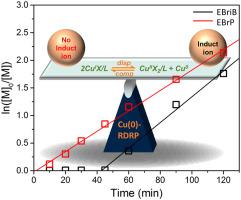Polymer ( IF 4.1 ) Pub Date : 2023-05-29 , DOI: 10.1016/j.polymer.2023.126055 Jing Lyu , Yongpeng Miao , Zishan Li , Yinghao Li , Yongsheng Gao , Melissa Johnson , Hongyun Tai , Wenxin Wang

|
There is a controversial debate about the mechanism of reversible deactivation radical polymerization (RDRP) in the presence of Cu(0). Two mechanism models have been proposed - supplemental activator and reducing agent atom transfer radical polymerization (SARA ATRP) and single-electron transfer living radical polymerization (SET-LRP), however, they are contradictory to each other, and neither of them are able to fully explain experimental phenomenon in the Cu(0)-mediated RDRP process, especially a period of slow addition i.e., induction period occurs under certain reaction conditions. In this work, the induction phenomenon and its underlying mechanism was explored and clarified by using different catalyst systems (CuI, Cu(0), Cu(0)&CuII) and different initiator systems i.e., EBriB (ethyl α-bromoisobutyrate), EBrP (ethyl 2-bromopropionate), MBrP (methyl 2-bromopropionate) and MClP (methyl 2-chloropropionate). New insights on the roles of different copper species and their mutual conversion kinetics were provided. It is proved that the appearance/absence of the induction period is due to the difference in the relative concentrations of CuI and CuII accumulated at the early stage of the reaction. Moreover, the disproportionation and comproportionation co-exist in the Cu(0)-mediated RDRP system and play an essential role in establishing the equilibrium among different copper species (Cu0, CuI and CuII) at the early reaction stage.


















































 京公网安备 11010802027423号
京公网安备 11010802027423号